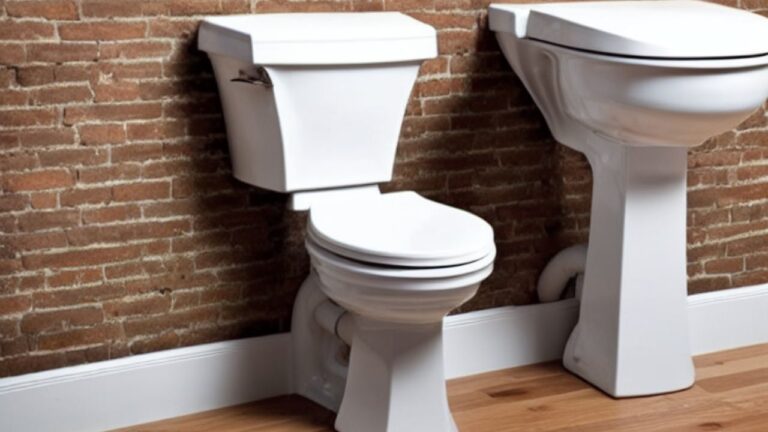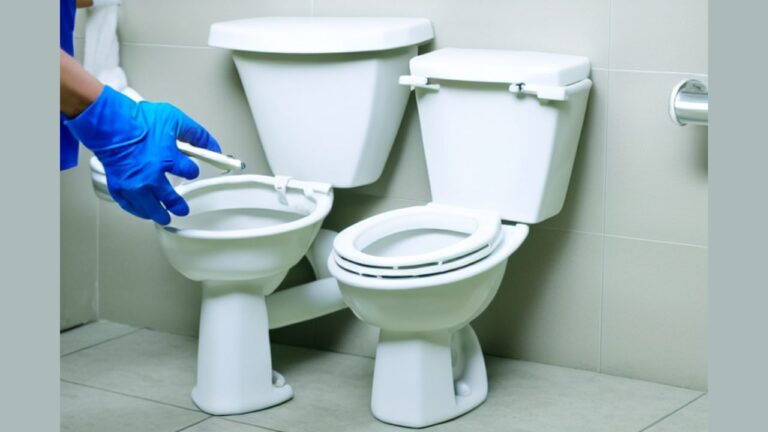This question has no definitive answer, as it depends on personal preferences and the specific installation.
But in general, most people prefer a toilet flange to be flush with the finished floor, while others may like a recessed flange for easier cleaning.
It is up to the homeowner to decide what looks best in their home.
- Does The Flange Need To Be Flush With The Floor?
- Are Toilet Flanges Different From Other Plumbing Fixtures?
- Best Practices When Installing a Toilet Flange
- Should A Flange Sit Just Above the Floor’s Surface – or As Close As Possible?
- What About Toilet Flanges That Are Too High?
- Benefits of Placing Toilet Flanges on Top of Tiles
- Potential Risks of Placing Toilet Flanges on The Floor
- Which Fixture to Use for a Particular Toilet?
- Conclusion
Does The Flange Need To Be Flush With The Floor?
When it comes to toilets, there are a lot of different opinions on what is best.
Some people believe the toilet flange should be flush with the finished floor, while others believe it should be slightly above the floor. So, what is the right answer?
There are a few things to consider when deciding whether or not the toilet flange should be flush with the finished floor.
One is aesthetics. If the flange is not flush with the floor, it can be a trip hazard and look unsightly. Another consideration is function.
If the flange is not flush with the floor, it can make it more difficult to install the toilet and keep it clean.
So, what is the best answer? Ultimately, it depends on your preference and what looks best in your bathroom.
If you are concerned about trip hazards, choose a flange slightly above the finished floor.
However, if you want your
When wondering if the flange needs to be flush with the floor, there are a few things to consider.
- The flange is part of the toilet that is bolted to the floor.
- The flange needs to be level with the floor so the toilet can be properly installed.
- If the flange is not level with the floor, it can cause the toilet to rock, leading to leaks, and the toilet will not be able to flush properly.
- In some cases, the flange may not be level with the floor because the floor is not level. In this case, shims can be used to level the flange. A shim is a small material used to fill in the gaps.
- If the flange is not level with the floor and shims cannot be used, the flange can be raised by adding a wax ring with a spacer.
- If the flange is too high, it can be lowered by removing the wax ring and shims.
Are Toilet Flanges Different From Other Plumbing Fixtures?
- Toilet flanges are different from other plumbing fixtures in that they are designed to be inserted into a hole in the floor and seal the space around the toilet drain. This helps to prevent leaks and odors from seeping into the bathroom.
- Toilet flanges are often made from metal or plastic and are attached to the bowl with screws or bolts.
- Toilet flanges come in various shapes and sizes and are designed to fit different bowls.
- Toilet flanges can be damaged by water and debris, leading to leakage and drainage problems.
- Toilet flanges can also become clogged with hair and other debris, leading to water flow and drainage problems.
- Toilet flanges can be replaced if they become damaged or need to be replaced due to leakage or drainage issues.
Best Practices When Installing a Toilet Flange
Ensure a flange height is adequate to prevent leaks from occurring.
The ideal solution would be installing toilet flanges underneath the finish floor.
When installing a toilet flange flush on the completed floor or below the finished floor, leak paths may form, as the flange isn’t positioned at an acceptable level to fit the horn underneath the toilet.
Follow the instructions below to get the best result for installing toilet flanges.
- Always use a new wax ring when installing a toilet flange.
- Make sure the flange is level before installing the toilet.
- Use a strong adhesive to secure the flange to the floor.
- Use the plumber’s putty or silicone caulk to seal the gap between the flange and the toilet.
- Tighten the bolts evenly to avoid damaging the flange.
- Use a wrench to tighten the bolts an additional 1/4 to 1/2 turn.
- Make sure the toilet is firmly seated on the flange before using it.
Should A Flange Sit Just Above the Floor’s Surface – or As Close As Possible?
When installing a flange, there are a few things to remember.
- A flange is a raised edge or lip on a surface. In the case of a floor, a flange should sit just above the floor’s surface or as close as possible.
- This flange provides support and stability to the floor, ensuring a level and even surface.
- A flange too high above the floor’s surface can create a trip hazard. If it is too low, it may not provide adequate support.
What About Toilet Flanges That Are Too High?
If the toilet flange is too high, the toilet will not sit properly on the flange and rock back and forth.
This can cause the toilet to leak at the base and damage the floor around the toilet.
If it is possible, install a new closet flange that is slightly higher than the old one.
The new flange should be no more than 1/4″ higher than the old one.
There are a few options If the toilet flanges are too high. One is to use a spacer ring to bring the flange up to the proper level.
Another is to use a new flange made to be used with a higher toilet.
Benefits of Placing Toilet Flanges on Top of Tiles
- Tiles can be easily cleaned and are less likely to become dirty or sticky than porcelain.
- Flanges protect the tiles from damage and make them easier to clean.
- Tiles can be installed quickly and easily, and there is no need for special tools or skills.
- Tiles can be installed in any direction, which makes them versatile and easy to adapt to various spaces.
- Tiles can be easily decorated or personalized to match the décor of a room.
- Flanges can be easily replaced if they become damaged or missing.
- Flanges can help to create a sense of height and openness in a room.
Potential Risks of Placing Toilet Flanges on The Floor
The potential risks of placing toilet flanges on the floor are that the flange may become dislodged and cause the toilet to become unstable and that the flange may become damaged from exposure to moisture or other elements.
Which Fixture to Use for a Particular Toilet?
There are a few factors that you need to consider when determining which type of fixture should be used for your toilet.
- The first factor is the size of the toilet. You will want to use a small fixture if you have a small toilet. You will want to use a large fixture if you have a large toilet.
- The second factor is the type of toilet. You will want to use a traditional fixture if you have a traditional toilet. You will want to use a tankless fixture if you have a tankless toilet.
- The third factor is the location of the toilet. You will want to use a small fixture if the toilet is in a small space. You will want to use a large fixture if the toilet is in a large space.
Conclusion
There is no one-size-fits-all answer to whether or not a toilet flange should be flush with the finished floor.
It depends on personal preferences and the specific installation.
Most people prefer a toilet flange to be flush with the finished floor, while others may like a recessed flange for easier cleaning.
Ultimately, it is up to the homeowner to decide what looks best in their home.
FAQ
If the flange is too low, you may need to adjust the size of the ring. The ring should be the same size as the flange.
The toilet flange should be installed at the correct height, 1/4″ above the finished floor.


